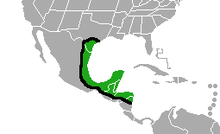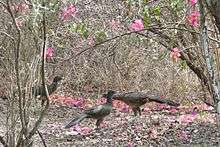Plain chachalaca
The plain chachalaca (Ortalis vetula) is a large bird in the chachalaca, guan and curassow family Cracidae. It breeds in tropical and subtropical environments from mezquital thickets in the Rio Grande Valley in southernmost Texas, United States to northernmost Costa Rica. In Central America, this species occurs in the Pacific lowlands from Chiapas, Mexico to northern Nicaragua and as a separate population in Costa Rica, where its range is separated by a short distance, as a disjunct population.
| Plain chachalaca | |
|---|---|
_national_butterfly_center%2C_missin%2C_hidalgo_co%2C_tx_-03_(31012955630).jpg) | |
| Scientific classification | |
| Kingdom: | Animalia |
| Phylum: | Chordata |
| Class: | Aves |
| Order: | Galliformes |
| Family: | Cracidae |
| Genus: | Ortalis |
| Species: | O. vetula |
| Binomial name | |
| Ortalis vetula Wagler, 1830 | |
 | |
| Approximate range (all-year resident) | |
This species frequents dry and moist forests, especially where interspersed with scrub and savanna. Usually found in groups of up to 15 birds, the plain chachalaca is furtive and wary and prefers to escape from danger by running swiftly on the ground or leaping and gliding through brushy tangles. The plain chachalaca feeds in trees or on the ground on fruit (figs, palms, Sapotaceae), seeds, leaves, and flowers. It is sometimes a pest of crops such as tomatoes and cucumbers.
The call is a loud, raucous RAW-pa-haw or cha-cha-LAW-ka, often by several birds in a rhythmical chorus, especially in early morning and evening, usually from well up in trees. It also produces peeping whistles and cackles. Others describe chachalaca calls as irritating noises mimicking a bunch of men arguing. The plain chachalaca typically breeds in the early wet season. The nest is a shallow saucer of twigs and plant fibers, lined with leaves, in thick vegetation. The clutch is 2–4 rough-shelled white to cream eggs.
Taxonomy
The plain chachalaca is related to the West Mexican chachalaca and the white-bellied chachalaca, and both of these were formerly considered a subspecies of the plain chachalaca . Today all major authorities recognize them as separate species. Their ranges slightly overlap in Mexico, but hybrids have not been reported between them.[2] The white-bellied chachalaca may be more closely related to the little chachalaca than the plain chachalaca.[3]
There are five recognized subspecies:
- O. v. deschauenseei – Bond, 1936 - Utila chachalaca: Utila Island, off Honduras
- O. v. mccallii – Baird, 1858: extreme southern Texas in the United States to northern Veracruz in Mexico
- O. v. intermedia – Peters, 1913: southern Yucatán (Mexico) to Belize and Guatemala, (sometime included in O. v. vetula)
- O. v. pallidiventris – Ridgway, 1887: northern Yucatán Peninsula
- O. v. vetula – (Wagler, 1830): nominate, southern Veracruz in Mexico to northwest Costa Rica
The isolated population in Costa Rica is assigned to the nominate race of the plain chachalaca, but has also been assigned to the white-bellied chachalaca and may in fact represent a new subspecies of the plain chachalaca - its plumage is close to this species than the white-bellied.[2]
Description
The plain chachalaca is a medium-sized galliform, around the size of a common pheasant. It measures 48–58 cm (19–23 in) in length, and varies in weight from 468–794 g (16.5–28.0 oz) for males and 439–707 g (15.5–24.9 oz)in females [2] Males are on average larger but because of overlap that isn't diagnostic of sex, and in appreance they are the same.[3] It is long-necked with a small head and bare throat patch which becomes deep red in both sexes during the breeding season.[2] Adults have a greyish head and neck with a dull olive-brown body and wings. The underbelly is pale to ochraceous and the tail is blackish with green gloss and buffy-white tip. The iris is brown and bill is black; orbital skin and the feet are dull grey.
Distribution and habitat

The plain chachalaca is found from Texas, in the Lower Rio Grande, through the eastern coast of Mexico, the Yucatán Peninsula, Belize, northern Guatemala, northern Honduras and just into the north central part of Nicaragua, with a small population on the Nicoya Peninsula of northern Costa Rica. The species has also been introduced and established to San Patricio County in Texas and three islands, Sapelo, Blackbeard and Little St. Simons Island, on the coast of Georgia.[3]
The plain chachalaca occupies a wide range of habitats, including primary forest, secondary forest, forest edge and riverine forest, thorny bush-scrub, and shrubland.[3] It is also found in human modified habitats such as orchards, suburban parks and gardens and croplands.[2] Unlike other cracids, it is able to adapt to the scrubland that arises after the clearing of tropical rainforest. It can be found from sea-level to 1,850 m (6,070 ft)[3]
Behavior
The plain chachalaca is mostly diurnal and is most active in cool mornings and in the evening. It is mostly inactive during the heat of the day. Pairs or family groups roost communally in trees, usually on a branch, often touching, and facing the same way.[3]
Hunting of the plain chachalaca is restricted to subsistence hunting, for example by the Mayan people in southern Mexico.[4] The plain chachalaca population is 500,000–5,000,000 (2006 IUCN Red List). It is not threatened. However the subspecies from Útila Island, O. v. deschauenseei, has sometimes been listed as extinct, but recent surveys have confirmed that it still survives.[5]
Chachalaca are viewed as a game animal in Texas. [6]
References
- BirdLife International (2012). "Ortalis vetula". IUCN Red List of Threatened Species. 2012. Retrieved 26 November 2013.CS1 maint: ref=harv (link)
- del Hoyo, J. & Kirwan, G.M. (2017). Plain Chachalaca (Ortalis vetula). In: del Hoyo, J., Elliott, A., Sargatal, J., Christie, D.A. & de Juana, E. (eds.). Handbook of the Birds of the World Alive. Lynx Edicions, Barcelona. (retrieved from http://www.hbw.com/node/53268 on 1 April 2017).
- Peterson, M.; Poole, A.; Gill, F. (2000). "Plain Chachalaca (Ortalis vetula)". The Birds of North America Online. Ithica: Cornell Lab of Ornithology. doi:10.2173/bna.550. Retrieved 1 April 2017.
- Jorgenson, Jeffrey P. (24 April 2009). "Maya subsistence hunters in Quintana Roo, Mexico". Oryx. 29 (01): 49. doi:10.1017/S0030605300020871.
- Glowinski, S.L. (2007). "The rediscovery of the Utila Island Chachalaca (Ortalis vetula deschauenseei)". Bulletin of the Cracid Specialist Group. 23: 28–29.
- https://tpwd.texas.gov/landwater/land/habitats/southtx_plain/upland_birds/chachalaca.phtml
- Stiles, F. Gary; Skutch, Alexander F. (1989). A Guide to the Birds of Costa Rica. Comstock Publishing Associates. ISBN 0-8014-9600-4.
External links
| Wikimedia Commons has media related to Ortalis vetula. |
| Wikispecies has information related to Ortalis vetula |
- BirdLife species factsheet for Ortalis vetula
- "Ortalis vetula". Avibase.

- Plain chachalaca Stamps from Mexico and Nicaragua at bird-stamps.org
- "Plain chachalaca media". Internet Bird Collection.
- Plain chachalaca photo gallery at VIREO (Drexel University)
- Plain Chachalaca species account at Neotropical Birds (Cornell Lab of Ornithology)
- Interactive range map of Ortalis vetula at IUCN Red List maps
- Audio recordings of Plain chachalaca on Xeno-canto.
- Straub, Robert (20 April 2012). "Plain Chachalaca calling". YouTube.
